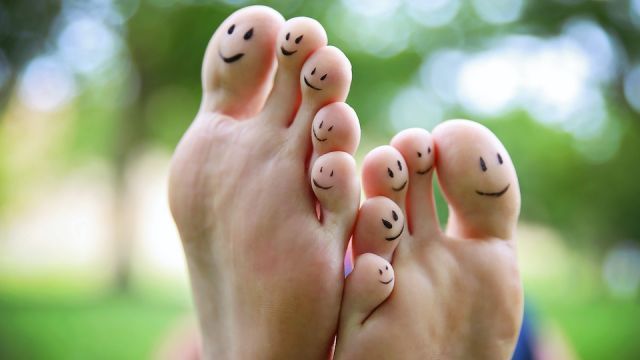
Most people will experience toe cramps, at some point in their life. Nothing is worse than waking up in the middle of the night with a cramping sensation in your toes. It may be mildly irritating or so intense that walking becomes difficult. In most cases, toe cramps are temporary and will diminish without treatment. However, some cramping may require an at-home remedy to diminish the pain. Here’s why your toes are cramping and what you can do to fix it.
There are many reasons why toes cramp
Your feet are made up of a myriad of tendons, ligaments, bones, joints, nerves, and muscles that all work together to support and move your foot and toes. So, there could be several reasons why your toes are cramping. However, there’s good news. Cramping toes aren’t usually a serious problem. Although they can be linked to medical conditions such as diabetes or hypothyroidism, certain lifestyle changes can help ease pain fast or even alleviate the cramping altogether. Here are some possible reasons why your toes are cramping.
Simple overexertion
Muscles in your feet contract and relax to create movement. So, repetitive motion, or forcing muscles to work harder during exercise can lead to toes cramping. Why cramping occurs during or after exercise is not known. However, research suggests that it may be linked to water and salt imbalance. It may also be linked to simple fatigue from overuse.
Gentle stretches to alleviate cramping toes
Stretching and strengthening exercises will help avoid toe cramps suggests the American Orthopedic Foot & Ankle Society. When you feel your toes cramp, actively lengthen the muscle by gently stretching the foot with these exercises:
- With your toes and the ball of your foot on the ground, raise your heel. Hold for five seconds, and then lower and repeat 10 times.
- Flex your foot so that your big toe points in one direction. Simply, hold for five seconds and repeat 10 times.
- Stand six inches from a wall. With your heel on the floor and your toe on the wall, bring your body towards the wall until you feel a stretch in your calf and foot. Muscles in your feet and calves are connected, which makes it important to stretch both.
Not enough exercise
On the other hand, not enough exertion can also lead to toe cramps. When you are not exercising regularly, joints become stiff, and muscles become tight. Exercising helps keep muscles strong and flexible, and joints lubricated. In fact, physical activity encourages circulation of the synovial fluid, which in turn, lubricates the joints, according to the Arthritis Foundation.
Quick fix — start moving!
The joints in your toes are surrounded by soft tissue called the synovial membrane. This produces a fluid similar to engine oil. So, get moving! Exercise helps encourage the circulation of the fluid, which keeps the bones in your feet moving past one another more smoothly.
But that’s not all. Exercise also helps blood flow and build muscles to help support the joints in your feet and toes. In addition, exercise allows nutrients to circulate to the joint, while cellular waste is removed.
Nutrient deficiency
Lacking certain nutrients may weaken nerve function, causing symptoms like cramping to worsen. Toe cramps may also be the result of deficiencies, particularly potassium, calcium, and magnesium. Magnesium, for instance, is the fourth most abundant mineral in the body according to research and is essential for 300 enzymatic reactions. Furthermore, it’s vital for regulating muscular contractions.
Replenish your electrolytes
Electrolytes help regulate many of your body’s most essential functions like nerve signaling, muscle contractions, pH balance, and hydration. Sodium, chloride, potassium, magnesium, calcium, phosphate, and bicarbonates are the significant electrolytes, and they come from the foods and fluids we consume. Electrolyte infused waters, coconut water, watermelon juice, and smoothies made with electrolyte-rich foods are all great ways to replenish nutrient deficiencies.
Additionally, if you think you may have a nutritional deficiency, contact your doctor for a simple blood test. Your doctor can quickly determine if you are deficient and require supplementation. For some people, supplementing with magnesium can help reduce toe cramps. However, studies on magnesium supplements for cramping have proven to be no better than taking a placebo. The reason may stem from the intricate relationship between magnesium and other nutrients. So, if you’re deficient in calcium and potassium, then supplementing with magnesium alone wouldn’t help. You need to consider all deficiencies.
Extra weight gain
Your toes and feet carry a heavy load each day. In fact, every extra pound you put on your frame adds an additional 10 pounds of pressure on your feet. Excess weight stretches and wears down the connective tissue in the feet, changes your gait, arches and tendons, according to research from the University Foot and Ankle Institute. Add ill-fitting shoes to the mix, and it’s a recipe for toe cramps.
Here’s how to fix it
Beyond losing the excess weight and wearing properly fitted shoes, you might want to consider adding orthotic shoe inserts to your shoes. Orthotics are designed to improve the fit between your foot and your shoe. Orthotics redistribute weight and eliminate undue friction and pressure.
When to see your doctor
As mentioned, cramping toes are generally not a cause for concern. However, if cramping does not subside on its own or with self-help, and is accompanied by:
- Severe discomfort or swelling
- Redness and skin changes
See your doctor to rule out a fracture, infection, or any underlying medical condition.
-Katherine Marko

